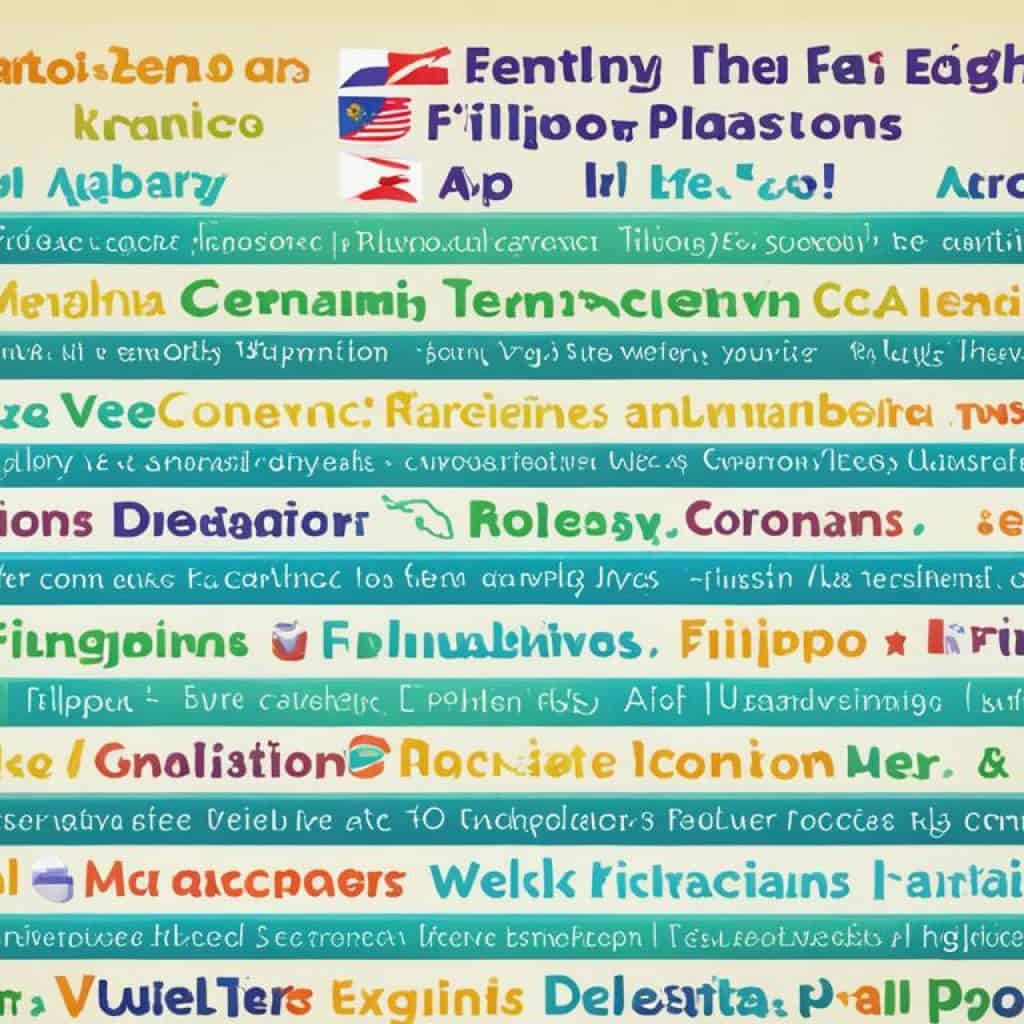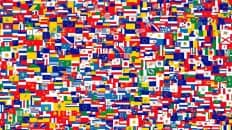Have you ever thought about mastering the Filipino language? What does it take to understand its many dialects and unique words? The Ultimate Filipino-English Dictionary Guide is here to help. It has over 20,000 entries, making it a comprehensive tool. This dictionary is perfect for those wanting to learn Filipino or English.
Ready to dive deep into the Filipino language? Let’s start this journey together. We’ll learn about the language’s rich history and its importance today. Understanding Tagalog’s evolution and language learning opens doors to new cultures. This will make you see language in a whole new light.
Key Takeaways:
- Gain access to over 20,000 entries in the Ultimate Filipino-English Dictionary Guide.
- Explore the evolution of Tagalog and its cultural significance.
- Discover the benefits of a bilingual dictionary app or online resource.
- Learn tips and strategies for maximizing your Filipino dictionary usage.
- Embrace the Filipino language as a means of cultural connection and exchange.
Understanding Tagalog Language and Culture
Exploring Filipino culture and history is key to understanding their language. Tagalog, or Pilipino, is the national language spoken by over 35 million people. This language captures the Filipino spirit, influenced by many cultures.
Understanding the culture behind Tagalog can make you a better translator. The language is used worldwide, speaking to the Philippines’ rich history. By learning about indigenous traditions and the effects of colonization, you understand the language’s depth.
“Language and culture are intertwined, and to fully comprehend the Tagalog language, one must also dive into the vibrant tapestry of Filipino culture.”
Studying Tagalog’s culture reveals communication’s intricacies. Filipino expressions reflect their history and environment. The phrase “Bahala na” shows resilience and faith, important to fully get their messages across.
The importance of respect and social hierarchy is evident in Filipino society. Using specific pronouns and terms shows understanding of relationships. Acknowledging these nuances helps in connecting deeply with Filipinos.
Filipino Cuisine: A Reflection of Culture
Food showcases Filipino culture’s richness. The Tagalog language has many culinary terms rooted in the country’s history. Dishes like adobo, sinigang, and lechon teach us about Filipino life and values.
| Traditional Filipino Dishes | Cultural Significance |
|---|---|
| Adobo | Reflects the preservation of meat during the Spanish colonial era |
| Sinigang | Highlights the abundance of fresh produce and the Filipinos’ love for sour flavors |
| Lechon | Serves as the centerpiece of celebrations, symbolizing hospitality and abundance |
Learning about Filipino food enhances language skills and cultural understanding. The recipes and traditions around food offer insights into Filipino society.
Diving into Tagalog and Filipino culture improves translation skills. Whether for personal growth or professional reasons, understanding this culture is crucial. Discovering the language and its cultural roots enriches your learning path and fosters love for Filipino identity.
The Importance of a Filipino-English Dictionary
In a world where communication is key, having a reliable Filipino-English dictionary is crucial. This tool helps bridge the language gap, allowing effective communication with Filipino speakers. It also aids non-Filipino speakers to engage with the Filipino community.
These dictionaries are invaluable for language learners, tourists, and anyone eager to connect with Filipino culture.
With a good Tagalog to English dictionary, you can:
- Expand your vocabulary and language skills
- Understand idiomatic expressions and slang
- Explore loan words and derivations
- Improve your communication with native Tagalog speakers
If you’re learning Tagalog or wish to connect with Filipinos, a Filipino-English dictionary is critical.
Having an English to Tagalog dictionary is also vital for non-Filipino speakers because it helps:
- Enjoy Filipino media, like songs, movies, and books
- Interact with the Filipino community, online and offline
- Communicate effectively in the Philippines, whether traveling or working
- Learn Filipino culture, traditions, and customs
These dictionaries enhance cross-cultural understanding and pave the way for meaningful connections. They are handy whether in physical form, online, or as an app. They help you navigate Filipino language challenges and appreciate Filipino culture more deeply.
Remember, language opens doors to new experiences, friendships, and cultural exchanges.
Bridge the Gap with a Filipino-English Dictionary
“Learning a new language opens a door to a new world. A Filipino-English dictionary makes that door wider, inviting exploration, connection, and growth.”
Embrace the power of language with a Filipino-English dictionary. These tools are key for education, work, or personal growth, facilitating effective communication and deep connections. Start your language learning journey today!
The Benefits of a Bilingual Dictionary
Accessing a Filipino dictionary is now super easy, thanks to tech advancements. Apps and online resources offer quick translations. This makes learning convenient.

These tools have cool features like voice pronunciation and learning exercises. They help enhance your language skills. Whether at home or on the move, you can dive into the Filipino language and grow your vocab.
For language learners, a reliable dictionary is key. Filipino dictionary apps and online resources let you look up new words fast. They provide clear translations and explanations, helping you to communicate better.
Listening to correct pronunciation is a big plus of bilingual dictionaries. Many apps and websites let you hear words spoken by native speakers. This improves your pronunciation and helps you understand the language better.
Furthermore, these dictionaries often give examples of how words are used. This shows you the correct context and usage. By seeing words in real sentences, you grasp their full meaning.
These dictionaries also come with fun learning exercises and quizzes. Exercises like fill-in-the-blanks and word games make learning fun. These tools help you remember vocabulary and understand Filipino grammar.
A bilingual dictionary is essential for learning Filipino. It offers instant translations, example sentences, and exercises. Whether you prefer an app or an online resource, it supports your learning journey.
Choosing the Right Filipino-English Dictionary
Picking the right Filipino-English dictionary is essential. You need accuracy, comprehensiveness, and ease of use. Find one that doesn’t just translate words. It should include slangs and idioms for a deep understanding of the language.
The format of the dictionary matters too. Do you like flipping through pages of a book? Or do you prefer digital versions for their convenience? Physical books are great for note-taking. Digital ones are portable and have features like bookmarking.
Getting the right Filipino-English dictionary will improve your language skills. Let’s look at top options that are accurate, comprehensive, and easy to use.
Oxford English-Tagalog Dictionary
The Oxford dictionary offers lots of Filipino words and their English meanings. It explains grammar, idiomatic expressions, and cultural context. This makes it a great tool for learners. It has over 160,000 words and phrases, covering many topics.
It also has clear pronunciation guides and is easy to use. This dictionary is good for all learners, whether you’re beginning or advanced. It provides a strong base for learning the language.
Collins English-Filipino Dictionary
This Collins dictionary is a great Filipino-English option. It has a wide vocabulary that includes slang and modern language. It gives bilingual examples and cultural insights for accurate translations.
You can get it in print or digital forms. It’s easy to use, with detailed entries and a good search function. This makes it helpful for learners.
| Dictionary | Features |
|---|---|
| Oxford English-Tagalog Dictionary | – Comprehensive collection of Filipino words and their English translations – Detailed grammar explanations and cultural context – Clear pronunciation guides – User-friendly interface |
| Collins English-Filipino Dictionary | – Extensive vocabulary, including colloquialisms and slang – Bilingual examples and cultural insights – Available in print and digital formats – User-friendly interface |
These dictionaries are just a start for your Filipino-English learning. Your personal learning style matters when choosing. With the right dictionary, your language journey will be successful. You’ll be able to communicate well in Filipino and English.
Exploring the Features of a Comprehensive Dictionary
A comprehensive Filipino-English dictionary has many features to help you learn the language. It gives you translations and extra info, like grammar and cultural notes. This makes learning much easier and more interesting.
By using a tagalog dictionary online or a filipino dictionary app, learning becomes handy. It aids students, travelers, or anyone keen on expanding their vocabulary. Having such a dictionary is crucial for language learners.
Grammatical Outlines and Examples
Grammar outlines are a main feature of these dictionaries. They show how Tagalog words work and are used. Clear explanations and samples make it easier to understand word contexts.
If confused about verb tenses or noun cases, a good Filipino-English dictionary can help. By checking grammatical outlines, you’ll improve your Tagalog grammar fast.
Cultural References and Vocabulary
These dictionaries also have cultural info and vocabulary. This helps you understand Filipino culture better. It makes talking with natives easier and helps you get their viewpoints.
They might include words specific to menus or Filipino holidays. This lets you socialize better and appreciate cultural details.
Traveler-Friendly Vocabulary
For travelers, a comprehensive dictionary is very useful. It includes terms for transportation, hotels, and common sayings. This helps a lot during trips to the Philippines.
With a tagalog dictionary online or a filipino dictionary app in your gadget, you have easy access to travel words. It makes your trip smoother and language learning more effective.
Enhancing Your Language Learning Goals
A good Filipino-English dictionary supports your language goals. It helps whether you’re improving in Tagalog, wanting better communication, or learning about Filipino culture. A quality dictionary is a great companion in your learning journey.
Think about your needs and how you learn best. Choose a dictionary that meets your goals. It should offer the right tools and resources for your language learning.
Tips for Maximizing Your Filipino Dictionary
A Filipino-English dictionary is a must-have tool for diving into the Filipino language. It helps you translate words and understand the culture behind them better. To make the most of your philippino english dictionary, consider these tips:
- Familiarize yourself with the dictionary’s organization and structure. Take some time to learn how the dictionary is put together. Knowing the layout makes it easier to find what you need fast.
- Use the example sentences to understand how words are used in context. Dictionary entries often have example sentences. These show how words fit into everyday speech. Use them to get a clear picture of word usage.
- Practice pronunciation with audio recordings, if available. Many dictionaries offer audio clips of words being pronounced. Listen to these to get your pronunciation right. It’s a great way to learn the sounds of the language.
- Consider creating flashcards or using built-in learning tools to reinforce your learning. Making flashcards of new vocabulary can really help. Or, use any learning tools that come with digital dictionaries. Things like quizzes or interactive exercises are great for remembering words.
Following these tips will boost your philippine english translation skills. Plus, you’ll gain a deeper insight into the Filipino language.
The Evolution of Tagalog Language
The Tagalog language has a rich history that spans centuries. It reflects the historical and cultural changes in the Philippines. To become a proficient Filipino language translator, one must understand this evolution.
Tagalog originated from the Austronesian language family in Southeast Asia. Through time, it evolved under Spanish colonization and American occupation. These periods introduced new words, grammar, and conventions to Tagalog, making it the dynamic language it is today.
Studying Tagalog’s evolution helps us understand its complexities and cultural importance. It shows how the Filipino identity and its diverse influences have been shaped. This understanding deepens our knowledge of the language.
Tagalog has adopted words from Spanish, English, Arabic, and Sanskrit over the years. These loanwords have enriched Tagalog’s vocabulary, enabling speakers to express new concepts. By exploring its evolution, we unlock language knowledge and appreciate the Filipino language’s unique cultural blend.
Filipino language translators need to grasp Tagalog’s history to capture its nuances and cultural references. They can then accurately translate phrases and idiomatic expressions, understanding their historical context.
The path to being a skilled Filipino language translator begins with learning about Tagalog’s history. By exploring its rich past, learners can grasp the cultural significance within the language. This makes them true ambassadors of Filipino culture.
Embracing the Filipino Language
Embracing the Filipino language is more than learning from a dictionary. It means diving into the culture and talking with native speakers. And, you need to practice the language often.
Learning Tagalog helps you connect with the Filipino community. It brings you closer to their vibrant culture. You can make deep, meaningful friendships this way.
By talking to Filipinos, you improve your language skills. You learn new slang and understand when to use certain phrases. It’s a great way to get better at speaking and listening.
Joining language learning groups is also a good idea. Online platforms help you meet speakers you can practice with. They offer chances for cultural exchanges and making new friends.
Learning a language is a journey that doesn’t end. Embracing Filipino is a big step towards becoming fluent. Keep looking for chances to practice, and you’ll grow your skills and cultural understanding.
Filipino Language Learning Resources
A reliable Filipino-English dictionary is crucial, but there’s more you can do. Various resources add to your learning journey. They include interactive lessons, exercises, and cultural programs. This blend helps you get a full grasp of the Filipino language.
Online resources are a top pick for learning Filipino. They have lessons that fit all skill levels, letting you learn at your speed. You also get to dive into Filipino culture with special programs. No matter your learning style, online resources can meet your needs.
Prefer learning while moving? Try language learning apps. They provide short lessons that fit into any schedule. It’s easy and flexible. These apps help you work on weak spots and track your improvement. Use them while traveling or during leisure time to make learning productive.
Using these tools along with a Filipino-English dictionary can boost your learning. Practice new words, grammar, and sentence structures. The dictionary’s examples and cultural insights also enhance your understanding of Filipino traditions.
Key Takeaways:
- Online platforms offer interactive lessons and cultural immersion programs for comprehensive language learning.
- Language learning apps provide bite-sized lessons and personalized learning experiences for on-the-go learning.
- Combining these resources with a Filipino-English dictionary enhances language learning progress.
Make the most of these Filipino language learning tools and start your journey to fluency. With commitment and the right resources, becoming confident in Filipino is within reach.
The Impact of Language on Cultural Identity
Language deeply shapes cultural identity and preserves our heritage. For the Filipino people, Tagalog is crucial in reflecting their shared experiences and values. It captures the essence of Filipino culture, keeping traditions and history alive.
Language is the key that unlocks the door to understanding and appreciating a culture. Through the Filipino language, we gain insights into the rich tapestry of the Filipino identity, enabling us to forge connections and foster meaningful relationships.
Studying Tagalog helps us appreciate Filipino heritage more. For non-Filipino speakers, a Filipino-English dictionary is key. It helps them understand the language and connect with Filipino culture.
Being able to translate between Tagalog and English opens up communication. It bridges language barriers and celebrates Filipino identity. It shows how diversity enriches us all.
The Role of Language in Cultural Preservation
Language keeps culture alive, passing traditions and stories to future generations. The Filipino language ensures the Philippines’ heritage continues. It connects people to their roots.
Tagalog captures Filipino customs and ways of life uniquely. It helps preserve cultural nuances. These aspects of the language give us a glimpse into what makes Filipino culture special.
Building Connections Through Language
Language connects people across cultures. Using a good Tagalog to English dictionary, non-Filipino speakers can deeply connect with Filipinos. This fosters deeper understanding and relationships.
Language is more than just words. It helps us understand values and perspectives. Learning Filipino brings us closer, building cultural bridges and mutual respect.
Preserving Cultural Diversity
The Philippines is home to over 170 languages, each unique. This shows the country’s rich cultural diversity. The Filipino language is a part of this colorful tapestry.
Respecting and valuing Filipino language helps preserve this diversity. A Filipino-English dictionary allows us to explore and appreciate the Philippines’ many languages and cultures.
| Language | Number of Speakers |
|---|---|
| Tagalog | Over 35 million |
| Cebuano | Over 20 million |
| Ilocano | Over 8 million |
| Hiligaynon (Ilonggo) | Over 7 million |
By celebrating the Filipino language, we see the power of language in connecting us. A Tagalog to English dictionary and appreciating linguistic diversity enhance our understanding. They promote cultural exchange and highlight the beauty of our shared humanity.
Language Learning as a Gateway to Cultural Exchange
Learning the Filipino language is more than just translating words. It opens the door to deep cultural exchange. By mastering the language, you can link diverse cultures, foster connections, and deepen understanding. Language learning becomes a tool to break barriers and celebrate diversity.
With tools like a Filipino English dictionary, you start a journey of cultural discovery. This journey helps build bridges between different communities.
Learning a new language is about more than just the words. It means diving into the culture and grasping the finer points of communication. When you learn Filipino, you uncover the rich culture, values, and life of the Filipino people. This lets you connect with the vibrant Filipino community and create strong relationships based on language and understanding.
“Language is the road map of a culture. It tells you where its people come from and where they are going.” – Rita Mae Brown
Being skilled in Filipino enables you to break down barriers and bond cultures. You help people communicate who otherwise couldn’t, encouraging understanding and teamwork. By welcoming the Filipino language, you make society more inclusive and diverse.
Learning a language lets you appreciate different viewpoints, traditions, and lifestyles. Navigating the Filipino language, you grow empathetic and culturally sensitive. These qualities are key for making meaningful connections and encouraging worldwide understanding.
Tools like a Filipino English dictionary are crucial for this learning journey. They give you what you need to grasp and translate Filipino nuances. Having a dictionary, either in print or online, ensures precise translations. It helps achieve your language learning aims.
Learning Filipino isn’t just about the language mechanics. It’s a celebration of diversity, culture, and mutual understanding. As a skilled translator, you open up cultural exchanges. You connect communities and help build a world that’s inclusive and interconnected.

Benefits of Language Learning:
- Enhanced communication skills
- Increased cultural awareness and sensitivity
- Expanded personal and professional opportunities
- Ability to connect with diverse communities
- Improved cognitive abilities
- Increased empathy and understanding
Conclusion
In conclusion, the Ultimate Filipino-English Dictionary Guide is essential for perfect Filipino communication. It has detailed entries, grammar tips, and cultural notes. This guide helps both learners and native speakers.
Embracing the Filipino language lets you deeply connect with Philippine culture. Whether using an online Tagalog dictionary or a Filipino dictionary app, it’s about cultural exchange. We celebrate diversity and build connections through language.







Add comment